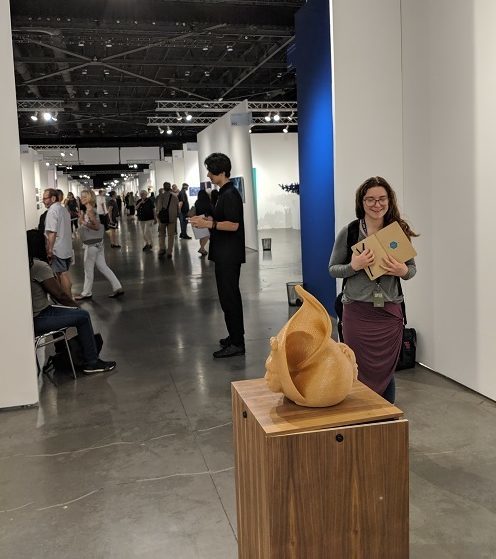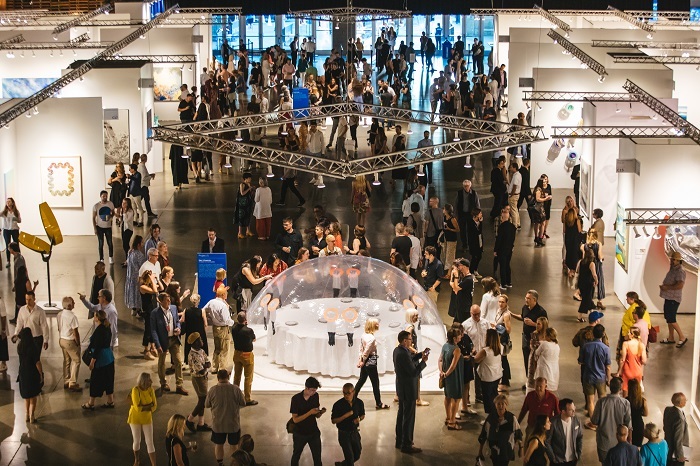Wonderful Art Fair, Happens to Be in Seattle
Review of the Seattle Art Fair.
Written by TeenTix Press Corps writer Rosemary Sissel.

A tunnel of captive trees reflects itself into infinity. Pieces of wood arranged in the shape of Africa cast the shadow of a face. Another face, painted by many tiny newspaper words, loses its eye.
The Fair is a river of continual images, inviting viewers to look at, question, and interact with collections from nearly one hundred galleries from around the world—and the variety is staggering. A head is suspended upside down by steel cable. A nose is a shoe. A plunger is glass.
In addition to this wealth of exhibitions, the Fair boasts many talks and a collection of special projects—nine specially curated exhibits. In "Not The Only One (N’TOO)," a learning AI robot holds the stories of three generations of African American women, and in another, giant, three-dimensional photographs document species that humans have genetically altered. "Self Facing" features a young woman who allows her face to sink into bread, while "Infinite Color and Sound" highlights a musician and visual artist, co-creating a live performance that is never the same twice. There are four large posters displaying vibrantly categorized objects by self-taught and Seattle-based Gregory Blackstock. And a woman, holding one of three mutant babies.
Artistic director Nato Thompson curated these projects to evoke a sense of the Wunderkammers (curiosity rooms) of the 16th and 17th centuries. These rooms—mostly curated by wealthy European men—overflowed with exotic objects, purchased, procured, or pilfered from decades of travel.
In a recent interview, Thompson explained their appeal. “Sometimes religious artifacts, sometimes a unicorn horn, sometimes a piece of art, sometimes science,” he listed the variety they held. “It was all undifferentiated; it blurred a lot of categories.” And, as he curated the projects and talks for the Fair, he kept this in mind, offering a wide array of experiences to visitors. Walking through them is nothing short of magical. They harken back to a time when everything was a mystery waiting to be uncovered.

Everything at the Fair creates a wonderfully overwhelming trip for the mind. Projects that ask questions about human intervention in the natural world. Talks that explore artificial intelligence and the shifting definition of life. Gallery upon gallery upon gallery that pelt viewers with drawing after painting after sculpture after photograph after construction. The sheer volume of images and experiences leads one to a greater sense of wonder. So many artists from all over the world making so many works of art in so many parts of the world.
It is a glorious celebration of art from many places. But not of art from Seattle. Out of ninety-six exhibitions, fourteen are put on by Seattle galleries. Out of the nine projects specifically curated for the Seattle art fair, one hails from Seattle. Out of four talks composed of a total of nine speakers and several kids for the kids’ panel, three speakers are from Seattle. (Hopefully, some of the kids for the kids’ panel are from Seattle, too.)
Thompson, the curator, is a really enthusiastic and nice human being. He’s easy to talk to, he wears short sleeve button ups, and he’s artistic director of Philadelphia Contemporary. He has curated for the Art Fair for two years now, and has very little to do with Seattle aside from that.
“Seattle is not the epicenter of the art world,” Thompson noted, “which, I think, is a great gift.” He mentions that, in other cities, “the rules are pretty set,” and that Seattle has a lot more room to play. “If you just catered to only an art audience, you would have a very tiny audience. This is a general audience that comes to the Seattle Art Fair.”
This is true. The lack of a constant art spotlight and the general audience do give Seattle room to try new things more easily. But that room to play just isn’t being taken full advantage of.
14.5% of galleries. 11% of projects. A third of speakers. (Plus some kids, we can hope.)
Booth prices are very expensive, in the past averaging “in the tens of thousands of dollars,” according to Emily Pothast in an article for Crosscut, and many Seattle galleries might have simply found it too costly to participate. This issue has been ongoing for the Fair’s five years, and seems challenging to address, but there are many other, rather easy, ways that the Seattle Art Fair could have chosen to be more Seattle.

At one of the projects, "Live Editions," I spoke with two artists who were creating live prints to be given away for free later. It featured “two national artists, Mark Gibson and Molly Crabapple,” according to the Fair’s website, but the two artists I met both worked for Party Hat, a Seattle gallery and printing shop. After we had chatted for a bit, and they spoke about the accessibility and fun (and political possibilities) that printmaking provides, one of them mentioned Party Hat.
“If you’re writing for TeenTix, maybe you could say something about us! We offer free printmaking for teens!” (That’s Andrea Marcos.)
“Yeah, sure! That’s really cool!” (That’s me.)
But as I said it, I felt a pang of guilt. Yeah, sure, I can mention this really wonderful opportunity in my small review, but imagine if the Seattle Art Fair had chosen to ‘feature’ the work of local printmakers? Or perhaps had just offered a little description of Party Hat in their glossy program, or on their website, or even in some simple sign by the project table?
The Art Fair is a wonderful opportunity to experience art from everywhere, to become overwhelmed with the magic of contemporary art and question such exciting mysteries as AI and humanity. It is a giant, cavernous room overflowing with glorious, exotic wonder collected from all corners of the globe. All the corners of the globe, and then just a smidge of the place where it all started. It is a wonderful and engaging art fair in Seattle, but not a particularly Seattle art fair.
Lead photo credit: Courtesy of Seattle Art Fair.
The TeenTix Press Corps promotes critical thinking, communication, and information literacy through criticism and journalism practice for teens. For more information about other Press Corps programs including Press Corps Intensives, the Teen Editorial Staff, or the TeenTix Newsroom, see HERE.

